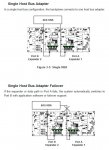Scampicfx
Contributor
- Joined
- Jul 4, 2016
- Messages
- 125
Hey folks,
I just orderer the items for my first big FreeNAS Server.
I ordererd Supermicro X10SRH-CF Mainboard and 846BE1C-R1K28B Chassis.
Link Mainboard: https://www.supermicro.nl/products/motherboard/Xeon/C600/X10SRH-CF.cfm
Link Chassis: https://www.supermicro.nl/products/chassis/4U/846/SC846BE1C-R1K28B
I would like to ask if it is the correct way, to use two SAS-cables, in order to connect the onboard LSI3008 to the backplane of the chassis? I had a look into the manual of the chassis, but i'm not quite sure, if I got it right.
Appendix E-1 of the Chassis Manual describes the backplane.
On page E-9 there is a picture of connecting the backplane:

(There are no cascading systems in my case...)
Question: Is it correct to put two SuperMicro CBL-SAST-0593 (SFF-8643 to SFF-8643) into one J50 port of the backplane?
I'm not sure if I need to use two or only one cable... In my opinion J50 is only one port, so it is able to handle only one cable, isn't it?
Thanks so much for your help! :)
I just orderer the items for my first big FreeNAS Server.
I ordererd Supermicro X10SRH-CF Mainboard and 846BE1C-R1K28B Chassis.
Link Mainboard: https://www.supermicro.nl/products/motherboard/Xeon/C600/X10SRH-CF.cfm
Link Chassis: https://www.supermicro.nl/products/chassis/4U/846/SC846BE1C-R1K28B
I would like to ask if it is the correct way, to use two SAS-cables, in order to connect the onboard LSI3008 to the backplane of the chassis? I had a look into the manual of the chassis, but i'm not quite sure, if I got it right.
Appendix E-1 of the Chassis Manual describes the backplane.
On page E-9 there is a picture of connecting the backplane:

(There are no cascading systems in my case...)
Question: Is it correct to put two SuperMicro CBL-SAST-0593 (SFF-8643 to SFF-8643) into one J50 port of the backplane?
I'm not sure if I need to use two or only one cable... In my opinion J50 is only one port, so it is able to handle only one cable, isn't it?
Thanks so much for your help! :)


